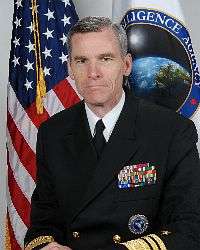Robert B. Murrett
| Robert B. Murrett | |
|---|---|
 | |
| 4th Director of the National Geospatial-Intelligence Agency | |
|
In office 2006–2010 | |
| President |
George W. Bush Barack Obama |
| Preceded by | James R. Clapper |
| Succeeded by | Letitia Long |
| Director of the Office of Naval Intelligence | |
|
In office 2005–2006 | |
| President | George W. Bush |
| Preceded by | Richard B. Porterfield |
| Succeeded by | Tony L. Cothron |
| Personal details | |
| Alma mater |
University at Buffalo Georgetown University Joint Military Intelligence College |
| Military service | |
| Service/branch | United States Navy |
| Rank |
Vice Admiral |
Vice Admiral Robert B. Murrett was the fourth Director of the National Geospatial-Intelligence Agency, from 7 July 2006 through July 2010. In 2011, Murrett joined the Institute for National Security and Counterterrorism at Syracuse University where he now serves as deputy director. He is also a faculty member of the Maxwell School of Citizenship and Public Affairs.
Military career
Following his commissioning into the United States Navy, Murrett was assigned as an afloat intelligence officer, including Mediterranean, North Atlantic, and western Pacific deployments aboard Kitty Hawk, America, and Independence
Following assignment to the Defense Intelligence College in 1980, Murrett was detailed to the Chief of Naval Operations Intelligence Plot (OP-009U) as a watch stander and briefing officer for Navy civilian and military leaders. From 1983 to 1985, he served as Assistant Intelligence Officer for Commander, Second Fleet. He participated in deployments to the North Atlantic, the European theater, and Caribbean aboard Mount Whitney and Nassau. Between 1986 and 1989, Murrett was assigned as Assistant Naval Attaché to the U.S. Embassy in Oslo, Norway.
In 1989, Murrett reported to Commander in Chief, U.S. Pacific Fleet, where he was assigned as Operational Intelligence Officer. From 1992 to 1995, he served as Assistant Chief of Staff, Intelligence for Commander, Carrier Group Eight, and deployed to the European and Central Command theaters aboard Theodore Roosevelt. Murrett was also assigned as J2 CJTF 120 aboard Wasp for operations in the Caribbean.
Between 1995 and 1997, Murrett was Assistant Chief of Staff, Intelligence for Commander, Second Fleet and served concurrently as N2 for NATO's Striking Fleet Atlantic and as J2 for U.S. Atlantic Command's CJTF 120. From June 1997 until September 1998, he was assigned to the Chief of Naval Operations Staff as Executive Assistant to the Director of Naval Intelligence. Murrett was then assigned as Director, Intelligence Directorate, Office of Naval Intelligence in September 1998. Murrett assumed the duties of Commander, Atlantic Intelligence Command (AIC) on 12 August 1999. He was responsible for the transition of AIC to Joint Forces Intelligence Command in October 1999. Murrett served as the Director for Intelligence, U.S. Joint Forces Command, from 10 August 2000 through 25 January 2002. From 31 January 2002 through March 2005, Murrett was assigned as the Vice Director for Intelligence, J2, on the Joint Staff. He served as the Director of Naval Intelligence from 1 April 2005 to 7 July 2006, when he became the director for the National Geospatial-Intelligence Agency.[1]
Education and training
Murrett received his bachelor's degree in history from the University at Buffalo in 1975, and master's degrees in government and strategic intelligence from Georgetown University and the Defense Intelligence College, respectively.
This article contains information from the United States Federal Government and is in the public domain.
References
- ↑ NGA more than Mapquest for the military Accessed 05-06-2008
| Military offices | ||
|---|---|---|
| Preceded by James R. Clapper |
Director of the National Geospatial-Intelligence Agency 2006–2010 |
Succeeded by Letitia Long |
| Preceded by Richard B. Porterfield |
Director of the Office of Naval Intelligence 2005–2006 |
Succeeded by Tony L. Cothron |